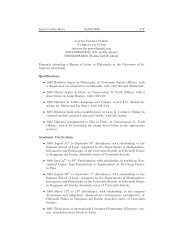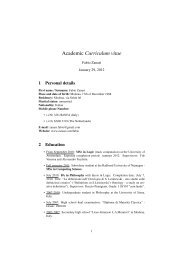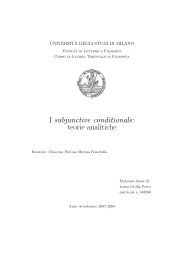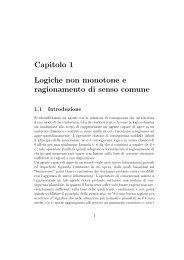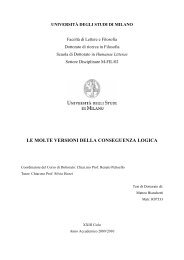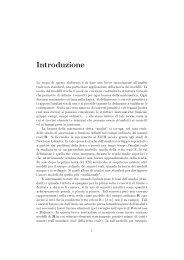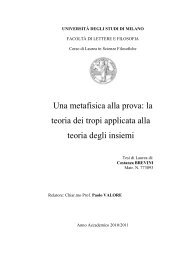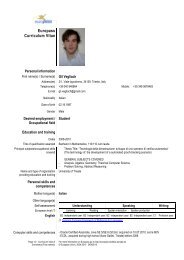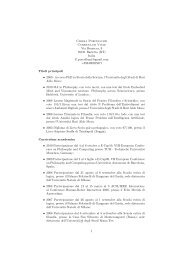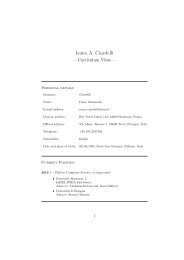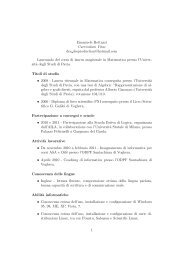Ω-Theory: Mathematics with Infinite and Infinitesimal Numbers - SELP
Ω-Theory: Mathematics with Infinite and Infinitesimal Numbers - SELP
Ω-Theory: Mathematics with Infinite and Infinitesimal Numbers - SELP
Create successful ePaper yourself
Turn your PDF publications into a flip-book with our unique Google optimized e-Paper software.
CHAPTER 1. Ω-CALCULUS<br />
1.5 The Transfer Principle<br />
In this section, we want to formulate a transfer principle for the notion of Ω-limit.<br />
Since a precise formulation of the transfer principle is possible only after the introduction<br />
of some logic formalism, we settle for an informal version where the<br />
important concept of of “elementary property” is left undefined.<br />
Transfer Principle (Informal version). An “elementary property” P is satisfied by<br />
real numbers ϕ1(λ), . . . , ϕk(λ) for all λ in a qualified set if <strong>and</strong> only if P is satisfied<br />
by the Ω-limits limλ↑Ω ϕ1(λ), . . . , limλ↑Ω ϕk(λ).<br />
In other words, Transfer Principle tells us that for all “elementary properties”<br />
P , the set QP = {λ ∈ Pfin(Ω) : P (ϕ1(λ), . . . , ϕk(λ)) holds} ∈ Q if <strong>and</strong> only if<br />
P (limλ↑Ω ϕ1(λ), . . . , limλ↑Ω ϕk(λ)) holds. If P is a property such as QP ∈ Q, we will<br />
say that P holds in a qualified set or that P holds almost everywere. Sometimes,<br />
we will also use the abbreviation “P holds a.e.”<br />
For now, the Transfer Principle can be taken only at an an informal, intuitive<br />
level, because we have no formal definition of an “elementary property” (<strong>and</strong> this<br />
is the reason why we always put “elementary property” between quotation marks).<br />
The content of Transfer Principle is made precise only when a rigorous definition of<br />
“elementary property” is given, <strong>and</strong> this will be done in Chapter 5 of this paper.<br />
Now we want to prove the Transfer Principle for some fundamental “elementary<br />
properties” we will use quite often.<br />
Proposition 1.5.1 (Transfer of inequalities). Let ϕ, ψ : Pfin(Ω) → R. Then<br />
1. ϕ(λ) = ψ(λ) a.e. if <strong>and</strong> only if limλ↑Ω ϕ(λ) = limλ↑Ω ψ(λ);<br />
2. ϕ(λ) < ψ(λ) a.e. if <strong>and</strong> only if limλ↑Ω ϕ(λ) < limλ↑Ω ψ(λ);<br />
3. ϕ(λ) ≤ ψ(λ) a.e. if <strong>and</strong> only if limλ↑Ω ϕ(λ) ≤ limλ↑Ω ψ(λ).<br />
Proof. To prove part 1, first notice that that, in both cases, Q = {λ ∈ Pfin(Ω) :<br />
ϕ(λ) = ψ(λ)} ∈ Q, <strong>and</strong> Proposition 1.4.8 ensures that Qϕ,ψ = Q c ∈ Q. Now, the<br />
thesis follows from Corollary 1.4.7.<br />
To prove part 2, suppose that ϕ(λ) < ψ(λ) a.e. We can define<br />
δ(λ) = ψ(λ) − ϕ(λ)<br />
<strong>and</strong> notice that, by hypothesis, Q = {λ ∈ Pfin(Ω) : δ(λ) > 0} ∈ Q. If limλ↑Ω δ(λ) ≤<br />
0, then we would have Q c ∈ Q, but once again this contradicts Proposition 1.4.8.<br />
The proof of part 3 can be obtained in a similar way.<br />
The reader should not think that all the properties of real numbers are elementary.<br />
Indeed, we can even show explicit counterexamples of properties that are not<br />
elementary.<br />
Example 1.5.2. As a property of real numbers, the property P (x) saying “x is a<br />
natural number” is not elementary, since |λ| ∈ N for all λ ∈ Pfin(Ω), but clearly<br />
14




